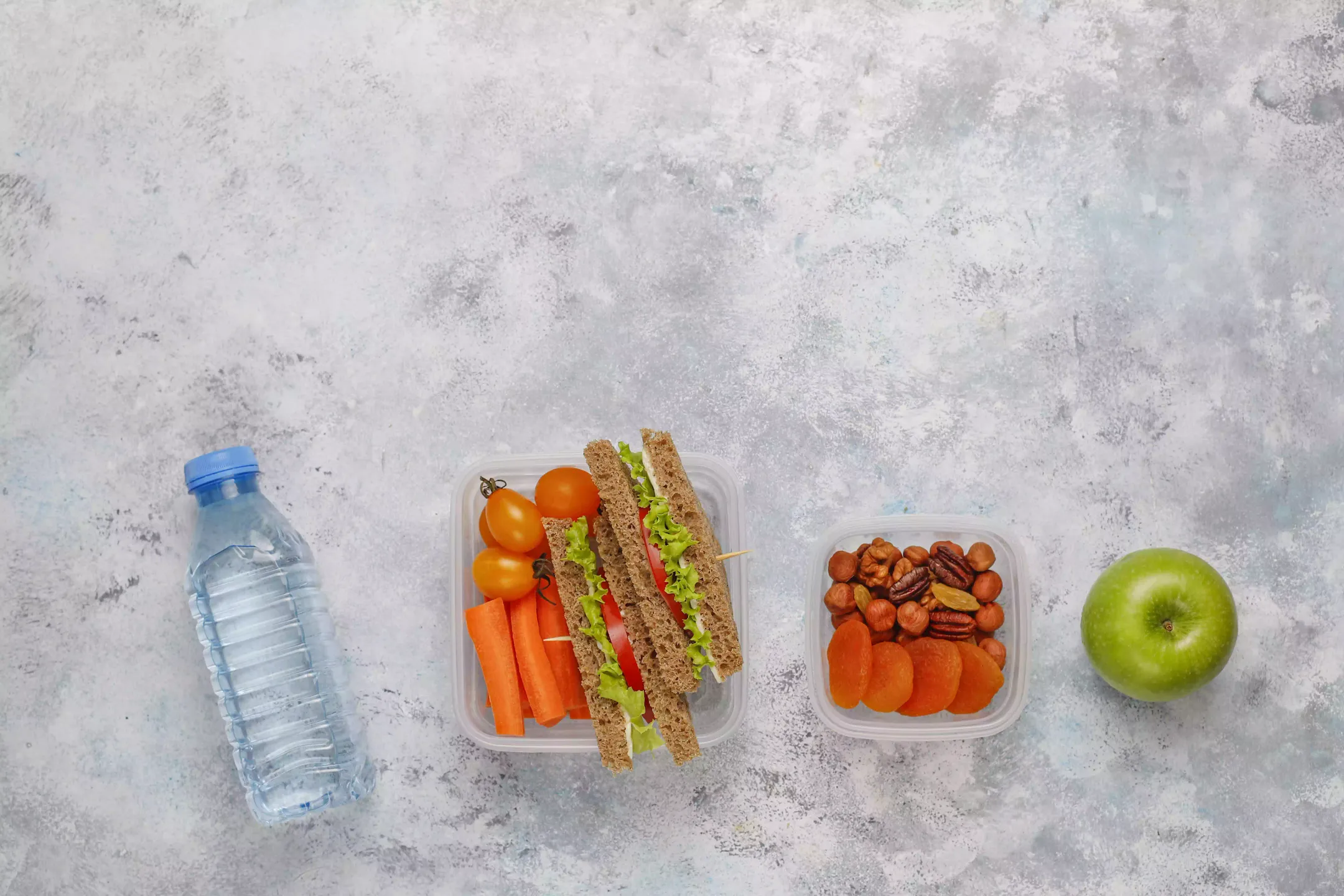
今すぐお問い合わせ
PETプラスチック食品は安全ですか?
食品容器を購入する際、多くの人がPETプラスチック製のものを選びます。しかし、この素材は食品にとって安全なのでしょうか?健康的な選択をするためには、PETプラスチックの特性を理解することが重要です。
この記事では、PETプラスチックとは何か、その用途、そして食品や健康への潜在的なリスクについて解説します。PETプラスチックについて正しい知識を得ることで、ご自身やご家族にとってより良い判断を下せるようになるでしょう。
PETプラスチックとは
PET樹脂は軽量で柔軟性が高いため、食品の保存や包装によく使用されています。PVCやポリスチレンなどの他のプラスチックとは異なり、PETは食品に安全なプラスチックとして認められており、リサイクル番号1が付けられていることがよくあります。この分類は、飲料ボトルや食品容器などに広く使用されていることを意味します。研究によると、PETはポリカーボネートやアクリルなどの素材に含まれるBPAなどの有害物質を溶出しないことが示されています。
食品にPETプラスチックを使用する場合は、食品グレードのラベルが付いていること、FDA(米国食品医薬品局)の承認を受けていること、そして安全基準を満たしていることを確認することが重要です。PETは優れた特性を持つ一方で、高温にさらされると劣化する可能性があるため、電子レンジでの使用や高温にさらすことは避けてください。また、PETはリサイクルと再利用が可能で、ガラスやステンレス製の容器に比べてキッチンで環境に優しい選択肢となります。これらの特性を理解することで、食品の加工や保管において、情報に基づいた選択が可能になります。
PET プラスチック食品は安全ですか?
食品グレードプラスチックの定義
食品グレードのプラスチックは、食品との接触における安全性と快適性が特徴です。HDPE、LDPE、ポリプロピレン、ポリカーボネートなどのこれらの素材は、BPAやPVCなどの有害な化学物質を使用せずに製造されています。FDAは、これらのプラスチックを食品に安全なものとして分類するためのガイドラインを制定し、食品への毒素の浸出を防止しています。研究によると、食品グレードのプラスチックは様々な温度に耐えることができ、電子レンジや食器洗い機での使用に適しています。

例えば、食品包装には柔軟なプラスチックが頻繁に使用される一方、アクリルやステンレス鋼などの丈夫な素材はキッチン用途でよく使用されます。腐食や融点の評価を含む試験プロセスにより、これらの材料が食品加工や保管の条件に耐えられることが確認されます。逆に、スチレン含有量が高い、またはリサイクル基準を満たしていないプラスチックなど、安全基準を満たしていないプラスチックは、リスクをもたらす可能性があります。
ガラス、セラミック、シリコンなどの代替容器も食品の保存には安全だと考えられていますが、食品に安全なプラスチックの多くはリサイクルや再利用が可能で、利便性と環境面でのメリットをもたらします。
食品安全プラスチックの規制基準
FDAなどの規制当局は、公衆衛生を守るため、食品に安全なプラスチックの基準を定めています。食品に浸出する可能性のあるBPAやスチレンなどの有害物質を検査することで、安全性を評価します。PET、HDPE、ポリプロピレン、LDPEなど、食品用途に承認されているプラスチックは、有害な化合物を放出することなく、様々な温度に耐えられるかどうかが評価されます。この評価は、電子レンジや食器洗いなど、キッチンで一般的に使用される条件下で行われます。
企業がこれらの基準を遵守すれば、PET樹脂を安全に包装に使用でき、柔軟で軽量な食品保存ソリューションを実現できます。基準を遵守しない場合、製品のリコールや消費者の信頼低下など、深刻な結果を招く可能性があります。調査によると、食品加工においては、ポリカーボネート、アクリル、ステンレス鋼などの安全な素材が好まれることが多いことが示されています。
プラスチックの安全性に不安のある方にとって、ガラス、シリコン、セラミックなどの容器は新たな選択肢となります。パッケージにリサイクルシンボルを表示することで、消費者はリサイクル可能なプラスチックを見分けやすくなり、食品関連用途における毒素を含まない素材の使用も促進されます。安全性へのこうした重点は、より優れた、再利用可能で、より持続可能なキッチン製品の開発に向けたイノベーションを促進します。
PETプラスチックの特性
PETプラスチックのリサイクル性
食品保存によく使用されるPET樹脂は、リサイクル率が1位であり、リサイクルしやすい材料の一つです。一般的なリサイクル方法は、プラスチックを洗浄、細断、溶解して新しい製品に再利用するメカニカルリサイクルです。研究によると、PET樹脂のリサイクルは廃棄物を大幅に削減できますが、食品にも安全な高密度ポリエチレン(HDPE)やポリプロピレンなどのリサイクルに比べると効果は劣ります。
PETのリサイクルにおける課題としては、製造に必要なエネルギーと、毒素を混入させる可能性のある食品残渣による汚染の可能性が挙げられます。しかし、研究の進歩により、これらのプロセスは改善されつつあります。ガラスやステンレス鋼といった、食品安全を考慮した様々な設計で提供されている他の安全な素材とは異なり、PETは電子レンジの高温など、極端な温度には限界があります。こうした課題にもかかわらず、PETは依然として軽量な包装材として優れた選択肢であり続けています。
ナイロンやポリカーボネートなどの他の素材には、BPA やその他の毒素が含まれているなど、特定のリスクがありますが、シリコンやセラミック容器などのより安全な代替品では、再利用可能なオプションが提供されます。
食品保存における耐久性と安全性
PET樹脂は、高い融点と柔軟性により、食品保存における耐久性の高さで知られています。幅広い温度に耐えられるため、冷蔵保存だけでなく、電子レンジでの軽い調理にも適しています。研究によると、PETを含む食品グレードのプラスチックは、適切に使用すれば有害物質の浸出がなく、食品との接触においても安全であることが示されています。
しかし、PVCやポリカーボネートなどの素材はBPAなどの毒素を放出する可能性があるため、安全性に関する懸念が生じる可能性があります。リスクを最小限に抑えるには、PETなどリサイクル番号1のプラスチックを使用することをお勧めします。これらのプラスチックは通常BPAを含まず、食品への安全性が認められています。ステンレス、ガラス、セラミック容器、シリコン容器、まな板なども安全な選択肢です。食器洗い機対応の素材で丁寧に洗浄することで、安全性を維持することができます。プラスチックの健全性を保つために、高温や腐食性物質への曝露は避けてください。
PETプラスチックに関する一般的な懸念
毒性と化学物質の浸出
PET樹脂は食品保存によく使用されますが、食品や飲料に毒素が浸出する懸念があります。BPA、スチレン、PVCなどの化学物質は、プラスチックを加熱したり日光にさらしたりすると、食品に浸出することがあります。研究によると、食品を電子レンジに入れるなど高温にすると、毒素の浸出速度が速まり、直射日光に長時間さらされると、このプロセスが加速することが分かっています。
したがって、HDPEやポリプロピレンなど、安全なリサイクル番号が付いたプラスチック容器を使用すると、食品に安全であることが知られているため、リスクを軽減できます。研究によると、食品グレードではないプラスチック容器に保存された食品の摂取は、ホルモンバランスを崩したり、その他の問題を引き起こす可能性のある毒素が原因で、健康問題につながる可能性があります。代わりに、ガラス容器、ステンレス鋼、またはシリコン容器を使用することで、食品の加工と保管においてより安全な選択肢となります。
軽量で食器洗い機で洗える素材に重点を置き、熱い食べ物にはポリカーボネートやアクリルなどの特定のプラスチックを避けることで、より安全なキッチン環境を作り、食べ物に毒素が残らないようにすることができます。
食品に安全なさまざまなプラスチックの比較
ポリプロピレンとPET
ポリプロピレンとPETはどちらも食品保存によく使われるプラスチックですが、それぞれ異なる特性を持っています。ポリプロピレンは融点が高く柔軟性に優れているため、電子レンジなど熱にさらされる可能性のある容器に適しています。一方、PETは軽量で、飲料やその他の食品の包装によく使用されます。どちらも食品に安全ですが、温度によって安全性が異なります。
研究によると、PETは特に高温時に微量の化学物質を放出する可能性がある一方、ポリプロピレンは毒性がなく、BPAやスチレンなどの有害物質の浸出が少ないことが知られています。リサイクル性に関しては、ポリプロピレンのリサイクル数は5で、様々な製品に再利用できます。一方、PETのリサイクル数は1で、広くリサイクルされています。このリサイクル性は環境の持続可能性に貢献し、どちらの素材もPVCやアクリルなどの代替素材よりも優れています。
食品加工においては、ステンレス鋼やシリコン容器などの安全な素材を選択することで、化学物質の浸出に関する懸念をさらに軽減できます。
PET と他のプラスチック
| プラスチック | 一般的な使用法 | BPA? | 食品は安全ですか? |
|---|---|---|---|
| ペット | 水筒、食品容器 | いいえ | はい |
| HDPE | 牛乳パック、洗剤ボトル | いいえ | はい |
| PVC | ラップ、ボトル類 | 時々 | 理想的ではない |
| LDPE | パン袋、冷凍食品袋 | いいえ | はい |
| PP | ヨーグルトカップ、電子レンジ対応容器 | いいえ | はい |
| 追伸 | 発泡スチロールカップ、テイクアウト容器 | いいえ | 現在では一般的に避けられています |
PETプラスチックカップの使用に関するヒント
1. リサイクルコードを確認する
消費者は、PETプラスチック製品に表示されているリサイクル番号を確認し、食品グレードの素材を使用していることを確認する必要があります。最も一般的なコードは1(PETE)で、これは一般的に食品の保存に安全とみなされており、2も食品に安全なプラスチックです。プラスチックの種類によってリサイクル性が異なるため、これらのコードを理解することで、消費者は持続可能性について十分な情報に基づいた選択を行うことができます。
例えば、HDPEは広くリサイクルされており、容器やまな板にも使用できますが、PETEは包装によく使用されますが、PETEほどの再利用性はありません。消費者は、PVCやポリスチレンなどのコード3~7を認識することで、BPAなどの毒素を溶出する可能性のあるプラスチックを識別できます。研究によると、食品加工にはガラス容器、ステンレス鋼、シリコン容器などのより安全な容器を使用することで、有害物質への曝露を減らすことができます。
さらに、リサイクルコードに許容温度範囲が記載されていることを知れば、電子レンジや食器洗い機でプラスチックを使用する際に、高融点でも安全に使用できることが保証されます。適切なリサイクルコードを使用することで、PETプラスチックの使用は軽量で耐腐食性があり、環境にも配慮したものになります。
2. 期間限定ドリンクの保管に
PETプラスチックを飲料の短期保存に使用する場合は、食品安全性を確保することが重要です。PETは軽量で飲料の包装によく使用されますが、飲料は一定期間内に消費する必要があります。物質を長期間保存すると、安全性と風味に影響を与える可能性があります。研究によると、PET容器内の飲料の品質は温度に影響を受ける可能性があり、例えば、熱によって望ましくない物質が放出される可能性があります。
飲み物を美味しく飲むには、涼しい場所に保管し、早めに飲み切ってください。破損した容器は有害物質が漏れる可能性があるため、使用を避けてください。環境安全のため、使用済みのPET容器はリサイクルすることをお勧めします。その他の安全な代替品としては、ガラス、セラミック、ステンレススチール製の容器があり、シリコン製の容器は柔軟性に優れています。ポリプロピレンやHDPEなど、FDA承認のプラスチック製で、底面にリサイクル番号が記載されているものは、食品の保管に安全です。
さらに多用途に使うには、安全なプラスチック製のまな板を調理中に使うのがおすすめです。必ず毒素を含まない素材を選び、食品安全包装でBPAなどの有害物質が含まれていないか確認してください。
3. 熱への曝露を避ける
PET樹脂は熱にさらされると有害物質を放出し、食品を汚染する可能性があります。ポリカーボネートや一部のPVCなどのプラスチックは、特に加熱すると毒素を溶出する可能性があります。研究によると、PET容器に入った食品を電子レンジで加熱したり、高温の食器洗い機に入れたりすると、リスクが生じる可能性があります。熱への曝露を避けるには、容器をオーブンの近くに置いたり、晴れた日に車内に放置したりするなど、熱の兆候に注意する必要があります。
ベストプラクティスとしては、HDPEやポリプロピレンなど、高温に耐えられることを示すリサイクル番号が付いた食品安全なプラスチックを使用することです。調理には、高温でも変形したり毒素を放出したりしないステンレス鋼、ガラス、シリコン、セラミックなどの素材の容器が適しています。熱にさらされる可能性のある食品の保存にはPETプラスチックの使用を避け、必ずメーカーの推奨温度範囲を確認してください。
これらの手順に従うことで、個人は食品を安全に保ち、プラスチックから浸出する有害な化学物質のリスクを軽減できます。
食品保存用PETプラスチックの代替品
ガラス容器
ガラス容器は、プラスチック容器に比べて食品保存において多くの利点があります。無毒で、BPA、PVC、スチレンなどの有害な化学物質を含まないため、食品の安全性を確保できます。時間の経過とともに劣化し、有害物質が浸出する可能性のあるプラスチックとは異なり、ガラスは汚染のリスクなしに食品の品質を保ちます。ガラスは耐熱性があるため、電子レンジでの加熱に適していますが、柔軟性のあるプラスチック容器は加熱すると変形したり、毒素を放出したりする可能性があります。
環境問題を意識している方にとって、ガラスはリサイクルと再利用が可能で、埋め立て廃棄物の増加につながる使い捨てプラスチックへの依存を減らすことができます。研究によると、適切に洗浄されたガラスは細菌の増殖を防ぎ、食品の保存においてより衛生的な選択肢となります。ポリプロピレンやHDPEなどの食品に安全なプラスチックの中には耐久性に優れたものもありますが、ガラスほどの持続可能性はありません。
ガラス容器を選択すると、使い捨て包装への依存が減り、よりクリーンな環境が促進されます。
ステンレススチールのオプション
食品保存用のステンレス鋼には、耐腐食性と耐高温性に優れた304や316など、様々なグレードがあります。BPAやフタル酸エステルなどの有害物質を含む可能性のあるプラスチックとは異なり、ステンレス鋼は食品に安全なソリューションを提供します。研究によると、ステンレス鋼はプラスチックよりも耐久性が高く、経年劣化によるひび割れや変形が発生しにくいことが分かっています。また、再利用可能、リサイクル可能、食器洗い機にも対応しているため、キッチンに最適な選択肢です。
プラスチック容器は、リサイクル番号が表示されていることが多いですが、その安全性は、高密度ポリエチレンなどの食品グレードのものから、毒素が浸出する可能性のあるポリカーボネートなどの安全性の低いものまで様々です。ナイロンやアクリルなどのプラスチックとは異なり、ステンレス鋼は軽量でありながら強度が高いため、食品加工に最適です。ガラスやセラミックの容器も安全ですが、壊れやすい場合があります。一方、ステンレス鋼はバターや残り物の保存など、様々な用途に適応できます。
正しい選択をすれば、安全性の低いプラスチックに関連する心配をすることなく、食品の安全と美味しさを確保できます。
ベストオプション - JKAI PETプラスチックカップ
JKAI PETプラスチックカップは食品グレードのプラスチック製で、食品を安全に保管し、美味しくお召し上がりいただけます。従来のカップとは異なり、軽量で柔軟性があり、扱いやすいです。BPAフリーで、PVCやスチレンなどのプラスチックによく含まれる有害な毒素も含まれていません。研究によると、PETプラスチックはFDA(米国食品医薬品局)によって食品との接触における安全性が認められており、飲み物や軽食の提供に最適なカップです。
さらに、これらのカップはリサイクル可能で再利用できるため、使い捨てのカップに比べて優れています。多くのユーザーは、食器洗い機で洗えること、高温に耐えられること、冷たいものにも温かいものにも使えることなど、その利便性を高く評価しています。レビューでは、頑丈さと耐腐食性が高く、イベントに最適であることも高く評価されています。ガラス容器やステンレススチール容器と比較して、JKAI PETプラスチックカップは安全性、使いやすさ、そして環境への配慮を兼ね備えており、食品加工やサービス提供において好まれる選択肢となっています。
概要
PETプラスチック(PETまたはPETEとも呼ばれる)は、食品や飲料の容器によく使用されるプラスチックです。リサイクルコード1を取得しており、その強度、軽量性、透明性が高く評価されています。
研究によると、PETは食品との接触において一般的に安全であると認識されています。米国食品医薬品局(FDA)は、PETの安全性プロファイルを裏付け、食品包装への使用を承認しています。研究によると、PETは通常の使用において食品に有害物質を放出しないことが示されています。
しかし、PETは使い捨てであれば安全ですが、繰り返し使用する場合の懸念があります。特に温かい食品や飲料に使用する場合、PET容器の再利用はプラスチックの劣化や化学物質の放出につながる可能性があります。
適切な保管条件も重要です。高温や直射日光はPETの完全性を損ない、汚染のリスクを高める可能性があります。そのため、メーカーは環境への影響を軽減するために、使い捨ての用途を推奨し、責任あるリサイクルを推進することがよくあります。
よくある質問
PET プラスチックは食品の保管に安全ですか?
はい、PETプラスチックは一般的に食品の保存に安全です。容器にはリサイクルコード#1が記載されていますので、ご確認ください。ペットボトルの水やサラダ容器など、使い捨ての食品にはPETプラスチックをご使用ください。加熱や複数回の再利用は、溶出を防ぐため避けてください。
PET プラスチックから有害な化学物質が食品に浸出する可能性がありますか?
PET樹脂は一般的に食品用途に安全と考えられており、通常の条件下では有害な化学物質の浸出はありません。ただし、PET容器を加熱したり、長期保存に再利用したりしないでください。より安全な方法として、食品や飲料の保存にはガラスまたはステンレス鋼を使用してください。
PET プラスチック容器にはどのような種類の食品を保存できますか?
PETプラスチック容器は、パスタ、米、シリアルなどの乾燥食品や、ジュース、スムージー、ソースなどの液体の保存に適しています。また、残り物、スナック、調理済みの食事の保存にも最適です。食品に安全であることを確認するために、必ずリサイクルマークを確認してください。
PET プラスチックは BPA を含まず、食品に使用しても安全ですか?
はい、PET樹脂はBPAフリーで食品用途にも安全です。水筒や食品容器によく使用されています。底面に記載されているリサイクルコード1を必ずご確認ください。また、メーカーのガイドラインをよく確認し、適切な使用と安全性を確保してください。
PET プラスチック食品容器はどのように洗浄し、メンテナンスすればよいですか?
PETプラスチック製の食品容器は、ぬるま湯と石鹸で洗うか、食器洗い機で洗ってください。刺激の強い化学薬品やたわしの使用は避けてください。変形を防ぐため、直射日光を避けて保管してください。頑固な汚れには、重曹ペーストを使用してください。定期的に傷や摩耗がないか点検し、必要に応じて交換してください。
